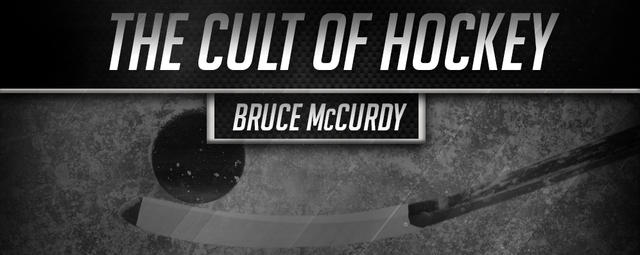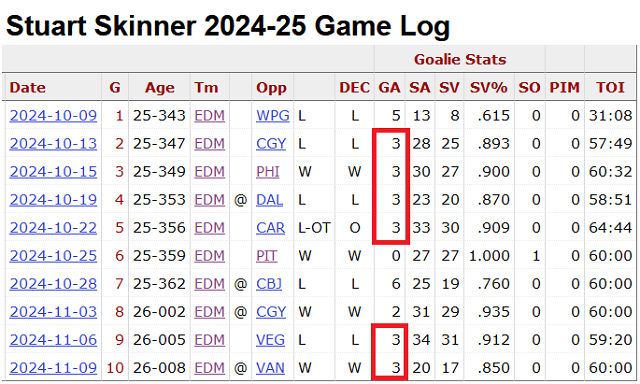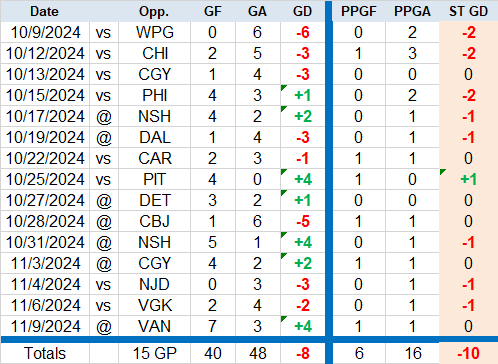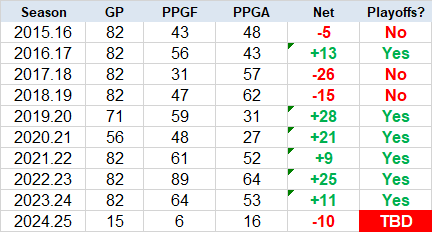The clock was winding down in Vancouver on Saturday night and things were looking up for the Edmonton Oilers. The visitors held a healthy 7-2 lead, doing most of the damage at 5v5 where they had outscored the ‘nucks 6-2, but they also held a rare one-goal advantage in special teams as well.
But down the stretch, Evan Bouchard took a careless penalty, then Darnell Nurse swatted down a puck right on to the stick of Elias Pettersson in the slot, in a flash the puck was in the net, and Stu Skinner was not happy. The game ended seconds later and the usually-affable stopper remained agitated. Or so it seemed from the comfort of my sofa a thousand-ish kilometres away, watching the somewhat brusque congratulations line that ensued. Nor was I the only one who noticed.
This just in: goalies are people too.
Few in Oil Country are under heavier scrutiny than the masked men in the blue paint. The scrutineers a.k.a. The Jury can be a demanding, “what have you done for us lately?” lot. Memories can be short; accomplishments like winning 5 straight elimination games in the playoffs (2 vs. Vancouver, 3 vs. Florida), or winning a series-long goaltending duel against a highly-rated contemporary like Jake Oettinger are already so “last year”.
Two theories about what might have been behind Skinner’s pique.
Two goals or fewer
It stands to reason that goalies are like other players in setting game-to-game objectives. Seems to this o-o-old goalie that in a “3-2 league”, one target might be to hold the opponent to 2 goals or fewer as often as possible. Which for Stu Skinner has not happened often enough in the young season; just twice in 10 starts.
On the bright side, also just twice in 10 starts has he yielded more than 3, in a pair of one-sided losses to Winnipeg and Columbus that the Oilers would have lost even had the ghost of Jacques Plante been tending the twine. The squad simply got blown out from front to back, goaltending most definitely included but just one part of a much bigger problem.
Skinner’s most common outcome by far this early season has been exactly 3 GA. In the three most recent cases, that third goal was scored “at the death”:
- 65th minute against Carolina. Skinner played well enough in regulation to limit the Hurricanes to 2 and earn his team a point, but the second one got away in frustrating fashion with some soft defensive coverage in the dying seconds of OT.
- 60th minute against Vegas, in this case breaking a 2-2 tie just before even one point was secure. A dagger that featured a sequence of errors by four different skaters, but Skinner couldn’t make them disappear with a big save at the crucial moment.
- now the 60th minute in Vancouver, the game safely won but another sloppy goal against near the end. It didn’t result in so much as a minus for any of the players on the ice (or in the sin bin for that matter) but was another black mark in the GA column for the goaltender. And, another pretty decent netminding/defensive performance rendered statistically “meh” by a late breakdown. Not hard to figure that the stopper might be a bit sour about it.
Searching the memory banks, I recalled one situation last season that was somewhat parallel. It was the last game before Christmas and after Skinner held them in the game early, the Oilers made a big third period comeback to assume command of a game at Madison Square Garden. But some soft defence in the late going led to a goal with literally 0.1 second on the clock to cut the winning margin to 4-3. Skinner was visibly less than thrilled that time too.
The team’s response was epic. After Christmas they won another 14 straight games without giving up 3 goals even once. Message delivered?
Special teams failures
My other thought is that Skinner is even more frustrated than Oilers fans with the ongoing misadventures of the penalty kill unit of which he is a feature member. The late tally marked 6 straight games the PK unit has allowed a goal, and the 12th time in 15 games overall. It’s a sorry record that sees Edmonton rank dead last in the league in penalty kill success rate (59%, or 6% worse than any other team) and in PPGA per 60 (16.5, or 2.3 worse than anybody else). The Oil are one of just 5 teams in the league to be shorthanded for less than an hour, but are nonetheless second worst in total goals allowed (16 in 58 minutes; leader Boston has allowed 17 in 106 minutes).
It’s a mind-boggling change of fortune from the PK machine that was so dominant in the playoffs for Edmonton. Over their 25-game run the Oilers were shorthanded for 127 minutes, yet allowed a measly 4 goals in total. Their stellar rate of 1.9 goals yielded per 60 was less than half the 4.2 of the second-best unit, Florida Panthers. Shockingly, the Oilers PK unit twice outscored the opposing powerplay over the course of an entire playoff series and broke even in a third.
Foundational to that success was outstanding netminding. Skinner’s .947 PPSv% was by far the best among NHL starters last spring despite the large sample size of 23 GP. Backup Calvin Pickard was even better at 1.000 in 3 appearances, and the Oilers as a team were off the charts at .953.
Those figures were clearly unsustainable in the longer term. Regression was inevitable under any circumstances, especially with the Oilers making a number of personnel changes to the unit over the offseason. Still, few would have expected the exact same goaltending tandem to rank dead last in PPSv% with just .686 through 15 games. Of the 52 goalies to play in at least 5 games so far, Pickard is at the bottom of the heap at .563 (7 goals on 16 shots, ugh), while Skinner is just 3 spots higher at .743 (9 GA on 35 shots). I dare say both have had a bellyful already.
Obviously their own performance is part of the problem this early season, just as it was part of the solution last playoffs. But the unit’s troubles extend far beyond goaltending.
Indeed, the issues on special teams in general extend past the penalty kill and include the powerplay as well. The netminders are off the hook entirely for that latter unit’s ponderous start.
Game-by-game special teams results
With their outburst in Vancouver the Oilers have finally got on the plus side of 5v5 goal share with 29 GF, 28 GA, but their overall count of 40 for, 48 against is still taking on water. The entire deficit can be attributed to not-so-special teams:
Starting with the left side of the table that features goals in all situations, it’s worth noting that the Oilers have been held to 2 goals or fewer in 8 of 15 games already, and are 0-7-1 in those games. When they score 3 or more, they’re 7-0-0. Suggesting it’s the (would-be) offensive players who are driving results more than the netminders, at least to this early point.
Zeroing in on special teams, we find 6 goals for, 16 against, wretched at both ends of the sheet. It’s a pure sample in that all 22 combined goals in the right hand columns have come at 5v4 with no shorthanded goals of any description for or against, nevermind category breakers like SHEN’s or similar.
The powerplay has been a headache in its own right, though there were positive signs in Vancouver with one goal scored just after the expiry of the first opportunity, later a second dynamic PP which didn’t quite click, then a third that connected right away.
Note how Edmonton’s combined odd-man units have outscored their opponent just once all season, 1 goal to 0 in Edmonton’s 4-0 shutout of Pittsburgh. They were this >
Special teams during the McDavid era
Make no mistake, special teams outscoring has been a huge factor in Edmonton’s success or lack thereof throughout the Connor McDavid era. Want a surefire indicator of making the playoffs? Check this out:
Note: these are powerplay goals only, shorties have not been factored in but would make little impact on the overall trend.
As things stand today, the 2024-25 Oilers are right on the cusp of playoff contention, tied with Utah Hockey Club for eighth in the west with a .500 points percentage through 15 games. Quite a bit better than that wretched -10 on special teams. the worst differential in the entire league. Stands to reason, though, that improvement on both specialty teams will produce more joy in the W-L columns as a natural byproduct.
Final comments
While Oilers fans are justified in their expectation that every player carry his share of the load, it’s worth remembering that the goaltending budget is inexpensive at just $3.6 million, barely 4% of the $88.5 million cap ceiling. Stu Skinner’s $2.6 million cap hit ranks 42nd in the NHL among goaltenders, even as over the past two seasons he was ninth in the league in regular season games played, sixth in wins, and third in both categories in the playoffs. In my view, his has been and remains a value contract.
That said, his game this early season has been a “half bubble off plumb”. No doubt it’s been frustrating for player and fans alike, and we maybe saw signs of that on Saturday. But his past history suggests he will find his groove sooner than later, and with it his trademark even keel.
Recently at the Cult of Hockey
STAPLES: There’ll never be another Grapes
McCURDY: Player grades in big win over Van
LEAVINS: 9 Things, including the availability of Dante Fabbro
STAPLES: Oilers could be younger, faster, more aggressive. So why aren’t they?
McCURDY: Oilers coaches find innovative ways to maximize d-corps
LEAVINS: Player grades from frustrating loss to Vegas


Follow me on X-Twitter @BruceMcCurdy


